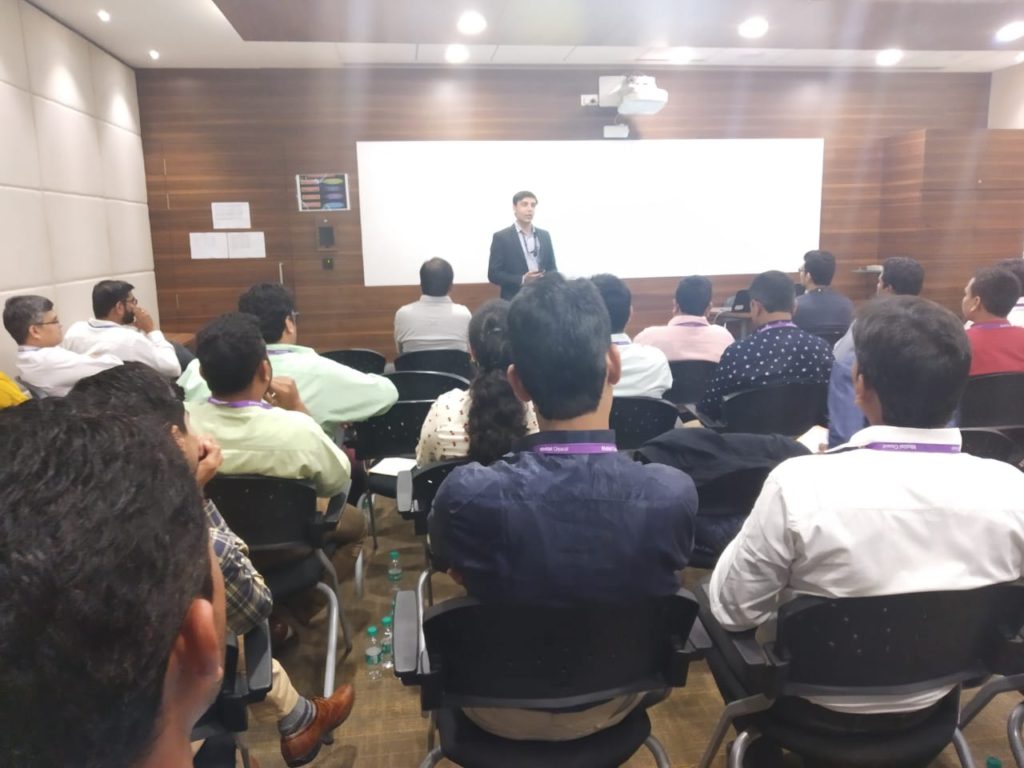
“Our conversation with Devang Mehta was all about delivering customer-centric experiences. As someone who started a professional career at as young as 15, his stories are a delight to hear.”
Fascinated by the idea of marketing, Devang has a terrific inclination towards creativity and the ability to analyze things. Having worked at numerous designations like Sales Promotion Manager, Business Development Executive, and Marketing Manager, today he is the Head of Marketing at Anand Rathi Group. He has significant experience in integrated marketing communications, client servicing, brand management, graphic designing, media planning and market research. His major contributions include Destimoney, Pencil to Pixel, Fasttrack Housing Finance, Motilal Oswal Financial Services and Anand Rathi Financial Services. Academically, Devang studied commerce and marketing. He is also an alumnus of ICFAI from where he finished his MBA.
The Seed of Creativity:
Devang shares his childhood experiences which instilled a sense of creativity in him. He shares about his after school visits to his dad’s printing press and his fascination with the visual designs created on the computers. This helped him understand the importance of visual representation at a young age. So the capabilities of designing software and the designs sowed in him the seed of creativity right in his childhood.
Devang talks about when he and his brother used to carry out various jobs to make some pocket money. He did odd jobs ranging from a telephone operator to selling petro-cards. Thus, early exposure to making money helped him understand finance from his childhood. Talking more about his choice of decisions he states,
“My current necessities in life and the way I look at things in the future, these two factors have been the major forces behind every decision in my life ever. For instance, doing the job of a telephone operator, carrying out promotional activities or joining my first full-time job at Destimoney. All have been a result of a current necessity and my foresight.”
Moving on towards his job days he shares,
“I have been able to build good relationships with the management in whichever companies I have worked.”
He believes that his humble beginnings have helped him to have an early work experience that undeniably gave him an edge over others. He started understanding about money and entrepreneurship in-depth when he started his own company Pencil to Pixel.
The Need for Visuals for the Sale of a Product:
Devang explains this by framing,
“Visuals are one of the most important factors. Not just in buying decisions but also creating a certain perception for an organization or a product/service.”
He further explains the impact of visuals over buying of a product with an example. If one enters a store and finds two different brands of a juice, both brands unknown to you, then subconsciously your mind will pick up the one with attractive packaging and visuals.
He states,
“Design has the power to change a person’s buying decision and the perception related to a product or service. But know that appealing packaging and good marketing campaigns can bring you first-time customers but then the next successful purchase will totally depend on the quality of your product.”
He also mentions factors like product features and the value addition that a product brings, play a crucial role.
The Impact of Designs:
We are surrounded by designs. Design is not only about the look and feel but also about the features. Humans have a tendency to get attracted to good looking things and hence are influenced by good designs.
He explains this in detail by the example of the design of a financial product. So unlike a physical product, the design of a financial product would be its look and feel, its features and the UI/UX of the app or website.
Stock Broking being a complex investment avenue, only a few opt for it. To combat this, they made their platform cleaner, simpler and used classical designs to attract more customers. They also added the customer’s portfolio to their homepage. This eventually led to an increase in the percentage of transactions happening online using the app and web. Thus, according to him the ease of using a platform and simplified version of things are crucial.

He further explains why ease of use is vital for consumer behaviour. Devang illustrates this by comparing two stockbroking companies. So the company which is able to execute quick transactions with minimum downtime undeniably performs better. Also, the ease of navigation and the capability of the app/website to help the investor invest almost instantly is the key factor as the stock market is absolutely dynamic.
He adds,
“Building something simple is not that difficult. It’s just that you have to put a lot of brain into it but you can come out with very simple interfaces easily. You have to just concentrate only on one thing that is EASE OF USE.”
Groundbreaking Change for the Finance Industry:
Devang agrees that technology has brought a revolution in the finance industry but his idea about a groundbreaking change is different. He focuses that finance companies today pay attention to ‘CUSTOMER ACQUISITION’ and not ‘CUSTOMER CREATION’. Educating the customers about stuff like equity, stocks and broking are the areas where most of the businesses lack. If people know where they are investing and how it works, it will eventually give rise to the conversion rate by instilling confidence in the investors.
One of the ways to do this is to incorporate the subject of finance right from school.
He further says,
“In 2020 alone, around 50-55% of adults in the U.S are investing in stock markets. So where are we compared to them? Only 4% to 5% of India’s population is investing in equity. Around 95% of people are still unaware of investing in Equity. If kids are taught finance right from childhood, they’ll start to invest from the age of 20-21 and be crorepatis in 10-15 years!”
Devang’s Approach Towards Building Trust in Customers about Stock Markets and Investing:
Trust is built through whatever a customer experiences, sees and reads about you.
Trust building involves marketing campaigns, the behaviour of the customer towards your product and the way the company handles the customer’s queries. He believes trust is a multi-faceted concept and cannot be built with one ideology. It’s a perpetual and continuous process that a business needs to carry through every touchpoint with its customers. Taking his financial platform as an example he explains that if we want people to invest through our platform then we need to give them logical reasons and correct them where they have gone wrong previously. We carry out various marketing campaigns to creatively illustrate the concept of investing and show people where they might go wrong.
He further talks about how AMFI has been successful in building trust in Mutual Funds by carrying out its campaign “Mutual Funds Sahi Hai” which created awareness and improved Mutual Fund’s penetration.
Risks in Investing:
There is risk in everything. But, just because people don’t know the potential of Equity and just have heard about the risks, they refuse to invest. But in reality, investing in equity is like investing in an extremely potential asset class which can give exponential returns. Although there are cycles in equities too, it has the highest potential in giving maximum returns. Unlike the incremental rise in gold or real estate investments, equity can give you exponential returns if you have the right advisor. He says,
“We as brokers personally feel that not investing in equity is a bigger risk. Because you risk not investing in such a significant asset class.”
He also focuses on having the right advisor while investing. So that the right advisor can understand and analyze your income and give a suitable investment plan for you which would match your risk-taking capabilities. This eliminates the fear of risk from the investor.
The Role of UX in a Marketing Plan:
Devang believes that UX is an important part of marketing and is deeply integrated with establishing a customer’s perception about you. So for instance, during the acquisition stage, if one runs a marketing campaign and a customer likes and clicks on it and the landing page does not load within a second then it creates a bitter experience. Moving further, if your customer tries to trade through your platforms and faces difficulty, that shows drawbacks in your UI/UX. Hence, every small thing which leads to experience is very important and should be well thought off and designed.
For a financial platform, it is necessary to have seamless transaction speeds, easy navigation and ability to understand the customer’s behaviour and provide a customised experience.
The Balance Between Marketing and UI/UX:
Devang explains that marketing and UI/UX are heavily integrated. But considering marketing in the broader sense, UI/UX becomes a part of marketing. He defines marketing as understanding consumer needs and fulfilling it. So this brings the realization that marketing and UI/UX already have a balance by default. In simple words, both the parties have the common goal of satisfying the customer and building a brand. He says,
“For me, marketing is a broad concept and UX is an integral part of it. Both the processes are ideally trying to achieve the same thing. So when two things are trying to achieve a common goal, one doesn’t need to strike a balance. The balance happens automatically.”

Handling Clashes in the Team:
There are certain decisions that are important for the business’s development. But these decisions or changes might face contradictory opinions from the management. In such situations, Devang says,
“As a marketing head, I will take a stand and make the team understand that we cannot compromise on a customer’s experience. Even one bad feedback from a customer can lead to losing hundreds and thousands of customers. This destroys the trust over the company which has been building for years.”
The USPs to Leverage Upon While Selling a Product:
Experience and trust are significant factors when it comes to selling a financial product. He shares that in order to create a trustworthy experience his team works on physical and digital touchpoints. Physical touchpoints include their own as well as partner branches. The way a customer is greeted and interacted when he/she visits their branch, understanding the customer’s profile, explaining their strategies for investments and writing down their goals also contribute to creating a standardized physical touch experience.
When it comes to digital touchpoints he says,
“Whether it’s the app/website/trading software, at every touchpoint we make sure our interface is user friendly and visually appealing. Our Online Products team is constantly improving our digital assets since it is a dynamic field.”
Adding more about their digital improvements, Devang shares that their platform has readymade baskets for people who are new to equity investing but want to invest. They have a Research and Advisory Division that does research on stocks and understands the pros and cons of buying a particular stock. This team helps create reports to understand how much one can get if invested for a certain period. He frames,
“If a layman wants to invest Rs.50,000 in best stocks, he doesn’t have to run here and there. He just has to select a basket. We have Speciality Chemical Baskets, Top Picks Basket etc which are based on expert recommendations. So by just one click, his money is invested in the top four to five research recommended companies.”
In this way, Devang and his team work on establishing better digital touchpoint experiences with technology.
How can Artificial Intelligence and Machine Learning Change Investment Decisions?
Devang agrees that Artificial Intelligence and Machine Learning would surely pave the way for a better investing journey but it will not replace the emotional quotient that we humans generally have while investing. The perspectives about investing money differ from person to person based on individual goals. He frames,
“AI and ML will create a much better platform for investing but it won’t be able to replace the human touch. In the end, I would definitely prefer to talk to a person and understand his views on investing rather than looking at a table created by AI or ML.”
What if Design Could Bring a Human Touch to Users? Will that Disruption Add Value to the Finance Industry?
Devang believes that any kind of disruption in the industry will add value to it. He further explains that a platform is just a medium for investing. In order to make a good amount of money, one needs to have an experienced advisor. If a platform can aid this human touch then such technology is always welcomed. So in this way, it will help brokers as well as investors to profit from a single platform.
He predicts that there might come a time when everyone will be more or less equal in terms of technology. He says,
“At such times the only differentiation that will remain will be the quality of research. So it’s obvious one will follow the research of a person who is helping you build wealth.”
He ends the interview by framing,
“You LEARN. You IMPROVISE. You MOVE FORWARD.”
Rapid Fire Round:
We also had a fun rapid-fire round with Devang!
- What’s your Bible? Books or Blogs?
Blogs
- Videos or Podcasts?
Videos
- Which is the app on your phone that you use every morning?
Money Control
- Which is your favourite item to cook?
Maggi and Coffee ☺
- Gas Stove or Microwave?
No comments
- Who is your Marketing Guru?
Philip Kotler




